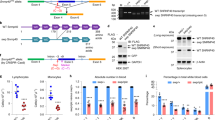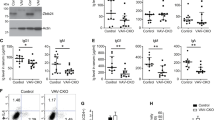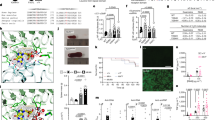Abstract
Bare lymphocyte syndrome (BLS) is an autosomal recessive severe-combined immunodeficiency that can result from mutations in four different transcription factors that regulate the expression of major histocompatibility complex (MHC) class II genes. We have identified here the defective gene that is responsible for the phenotype of the putative fifth BLS complementation group. The mutation was found in the regulatory factor that binds X-box 5 (RFX5) and was mapped to one of the arginines in a DNA-binding surface of this protein. Its wild-type counterpart restored binding of the RFX complex to DNA, transcription of all MHC class II genes and the appearance of these determinants on the surface of BLS cells.
This is a preview of subscription content, access via your institution
Access options
Subscribe to this journal
Receive 12 print issues and online access
$209.00 per year
only $17.42 per issue
Buy this article
- Purchase on Springer Link
- Instant access to full article PDF
Prices may be subject to local taxes which are calculated during checkout






Similar content being viewed by others
Accession codes
References
Benoist, C. & Mathis, D. Regulation of major histocompatibility complex class-II genes: X, Y and other letters of the alphabet. Annu. Rev. Immunol. 8, 681–715 (1990).
Boss, J.M. Regulation of transcription of MHC class II genes. Curr. Opin. Immunol. 9, 107–113 (1997).
Cogswell, J.P., Zeleznik-Le, N. & Ting, J.P. Transcriptional regulation of the HLA-DRA gene. Crit. Rev. Immunol. 11, 87–112 (1991).
Cresswell, P. Assembly, transport, and function of MHC class II molecules. Annu Rev. Immunol. 12, 259–293 (1994).
Glimcher, L.H. & Kara, C.J. Sequences and factors: a guide to MHC class-II transcription. Annu. Rev. Immunol. 10, 13–49 (1992).
Durand, B. et al. RFXAP, a novel subunit of the RFX DNA binding complex is mutated in MHC class II deficiency. EMBO J. 16, 1045–1055 (1997).
Masternak, K. et al. A gene encoding a novel RFX-associated transactivator is mutated in the majority of MHC class II deficiency patients. Nature Genet. 20, 273–277 (1998).
DeSandro, A.M., Nagarajan, U.M. & Boss, J.M. Associations and interactions between bare lymphocyte syndrome factors. Mol. Cell. Biol. 20, 6587–6599 (2000).
Nekrep, N., Jabrane-Ferrat, N. & Peterlin, B.M. Mutations in the bare lymphocyte syndrome define critical steps in the assembly of the regulatory factor X complex. Mol. Cell. Biol. 20, 4455–4461 (2000).
Steimle, V. et al. A novel DNA-binding regulatory factor is mutated in primary MHC class II deficiency (bare lymphocyte syndrome). Genes Dev. 9, 1021–1032 (1995).
Jabrane-Ferrat, N., Fontes, J.D., Boss, J.M. & Peterlin, B.M. Complex architecture of major histocompatibility complex class II promoters: reiterated motifs and conserved protein-protein interactions. Mol. Cell. Biol. 16, 4683–4690 (1996).
Steimle, V., Otten, L.A., Zufferey, M. & Mach, B. Complementation cloning of an MHC class II transactivator mutated in hereditary MHC class II deficiency (or bare lymphocyte syndrome). Cell 75, 135–146 (1993).
Fontes, J.D., Kanazawa, S., Nekrep, N. & Peterlin, B.M. The class II transactivator CIITA is a transcriptional integrator. Microbes Infect. 1, 863–869 (1999).
Zhu, X.S. et al. Transcriptional scaffold: CIITA interacts with NF-Y, RFX, and CREB to cause stereospecific regulation of the class II major histocompatibility complex promoter. Mol. Cell. Biol. 20, 6051–6061 (2000).
Mach, B., Steimle, V., Martinez-Soria, E. & Reith, W. Regulation of MHC class II genes: lessons from a disease. Annu. Rev. Immunol. 14, 301–331 (1996).
Reith, W. & Mach, B. The bare lymphocyte syndrome and the regulation of MHC expression. Annu. Rev. Immunol. 19, 331–373 (2001).
Villard, J., Masternak, K., Lisowska-Grospierre, B., Fischer, A. & Reith, W. MHC class II deficiency: a disease of gene regulation. Medicine 80, 405–418 (2001).
Hauber, I. et al. Molecular characterization of major histocompatibility complex class II gene expression and demonstration of antigen-specific T cell response indicate a new phenotype in class II-deficient patients. J. Exp. Med. 181, 1411–1423 (1995).
Douhan, J. III, Hauber, I., Eibl, M.M. & Glimcher, L.H. Genetic evidence for a new type of major histocompatibility complex class II combined immunodeficiency characterized by a dyscoordinate regulation of HLA-D α and β chains. J. Exp. Med. 183, 1063–1069 (1996).
Kelly, P.F., Vandergriff, J., Nathwani, A., Nienhuis, A.W. & Vanin, E.F. Highly efficient gene transfer into cord blood nonobese diabetic/severe combined immunodeficiency repopulating cells by oncoretroviral vector particles pseudotyped with the feline endogenous retrovirus (RD114) envelope protein. Blood 96, 1206–1214 (2000).
Emery, P., Durand, B., Mach, B. & Reith, W. RFX proteins, a novel family of DNA binding proteins conserved in the eukaryotic kingdom. Nucleic Acids Res. 24, 803–807 (1996).
Gajiwala, K.S. et al. Structure of the winged-helix protein hRFX1 reveals a new mode of DNA binding. Nature 403, 916–921 (2000).
Peitsch, M.C. ProMod and Swiss-Model: Internet-based tools for automated comparative protein modelling. Biochem. Soc. Trans. 24, 274–279 (1996).
Fontes, J.D., Jabrane-Ferrat, N. & Peterlin, B.M. Assembly of functional regulatory complexes on MHC class II promoters in vivo. J. Mol. Biol. 270, 336–345 (1997).
Jabrane-Ferrat, N., Nekrep, N., Tosi, G., Esserman, L.J. & Peterlin, B.M. MHCII transcriptional platform: Assembly of NFY and RFX on DNA requires RFX5 dimers. Mol. Cell. Biol. 15, 5616–5625 (2002).
Villard, J. et al. A functionally essential domain of RFX5 mediates activation of major histocompatibility complex class II promoters by promoting cooperative binding between RFX and NF-Y. Mol. Cell. Biol. 20, 3364–3376 (2000).
Peretti, M., Villard, J., Barras, E., Zufferey, M. & Reith, W. Expression of the three human major histocompatibility complex class II isotypes exhibits a differential dependence on the transcription factor RFXAP. Mol. Cell. Biol. 21, 5699–5709 (2001).
Kobr, M., Reith, W., Herrero-Sanchez, C. & Mach, B. Two DNA-binding proteins discriminate between the promoters of different members of the major histocompatibility complex class II multigene family. Mol. Cell. Biol. 10, 965–971 (1990).
Mach, B., Steimle, V. & Reith, W. MHC class II-deficient combined immunodeficiency: a disease of gene regulation. Immunol. Rev. 138, 207–221 (1994).
Reith, W. et al. Cooperative binding between factors RFX and X2bp to the X and X2 boxes of MHC class II promoters. J. Biol. Chem. 269, 20020–20025 (1994).
Clausen, B.E. et al. Residual MHC class II expression on mature dendritic cells and activated B cells in RFX5-deficient mice. Immunity 8, 143–155 (1998).
Cavazzana-Calvo, M. et al. Gene therapy of human severe combined immunodeficiency (SCID)-X1 disease. Science 288, 669–672 (2000).
Bulger, M. & Groudine, M. Looping versus linking: toward a model for long-distance gene activation. Genes Dev. 13, 2465–2477 (1999).
Orphanides, G. & Reinberg, D. A unified theory of gene expression. Cell 108, 439–451 (2002).
Scholl, T., Mahanta, S.K. & Strominger, J.L. Specific complex formation between the type II bare lymphocyte syndrome-associated transactivators CIITA and RFX5. Proc. Natl. Acad. Sci. USA 94, 6330–6334 (1997).
Fontes, J.D., Kanazawa, S., Jean, D. & Peterlin, B.M. Interactions between the class II transactivator and CREB binding protein increase transcription of major histocompatibility complex class II genes. Mol. Cell. Biol. 19, 941–947 (1999).
Kretsovali, A. et al. Involvement of CREB binding protein in expression of major histocompatibility complex class II genes via interaction with the class II transactivator. Mol. Cell. Biol. 18, 6777–6783 (1998).
Spilianakis, C., Papamatheakis, J. & Kretsovali, A. Acetylation by PCAF enhances CIITA nuclear accumulation and transactivation of major histocompatibility complex class II genes. Mol. Cell. Biol. 20, 8489–8498 (2000).
Raval, A. et al. Transcriptional coactivator, CIITA, is an acetyltransferase that bypasses a promoter requirement for TAF(II)250. Mol. Cell 7, 105–115 (2001).
Masternak, K. & Reith, W. Promoter-specific functions of CIITA and the MHC class II enhanceosome in transcriptional activation. EMBO J. 21, 1379–1388 (2002).
Tosi, G. et al. HIV-1 Tat mutants in the cysteine-rich region downregulate HLA class II expression in T lymphocytic and macrophage cell lines. Eur. J. Immunol. 30, 19–28 (2000).
Nekrep, N., Geyer, M., Jabrane-Ferrat, N. & Peterlin, B.M. Analysis of ankyrin repeats reveals how a single point mutation in RFXANK results in bare lymphocyte syndrome. Mol. Cell. Biol. 21, 5566–5576 (2001).
Nicholls, A., Sharp, K.A. & Honig, B. Protein folding and association: insights from the interfacial and thermodynamic properties of hydrocarbons. Proteins 11, 281–296 (1991).
Acknowledgements
We thank P. Zupanc-Ecimovic for secretarial assistance; E. Vanin for the RD114 retroviral system and advice; G. Tosi for D1.12 and B7.21 antibodies; and other members of our laboratory for helpful discussions. Supported by the Peter und Traudl Engelhorn Stiftung (M. G.) and a grant from Nora Eccles Treadwell Foundation.
Author information
Authors and Affiliations
Corresponding author
Ethics declarations
Competing interests
The authors declare no competing financial interests.
Supplementary information
Rights and permissions
About this article
Cite this article
Nekrep, N., Jabrane-Ferrat, N., Wolf, H. et al. Mutation in a winged-helix DNA-binding motif causes atypical bare lymphocyte syndrome. Nat Immunol 3, 1075–1081 (2002). https://doi.org/10.1038/ni840
Received:
Accepted:
Published:
Issue Date:
DOI: https://doi.org/10.1038/ni840



